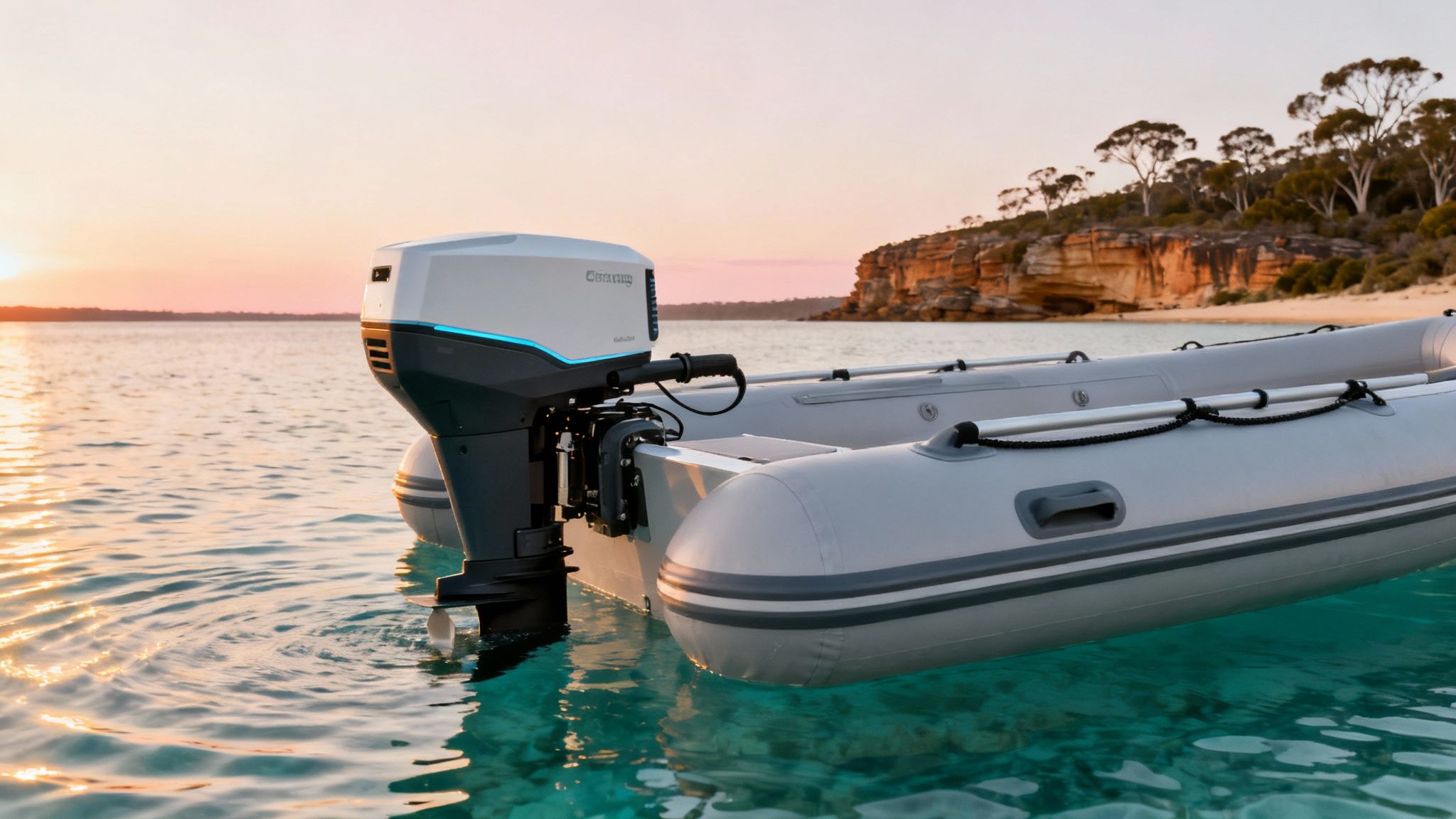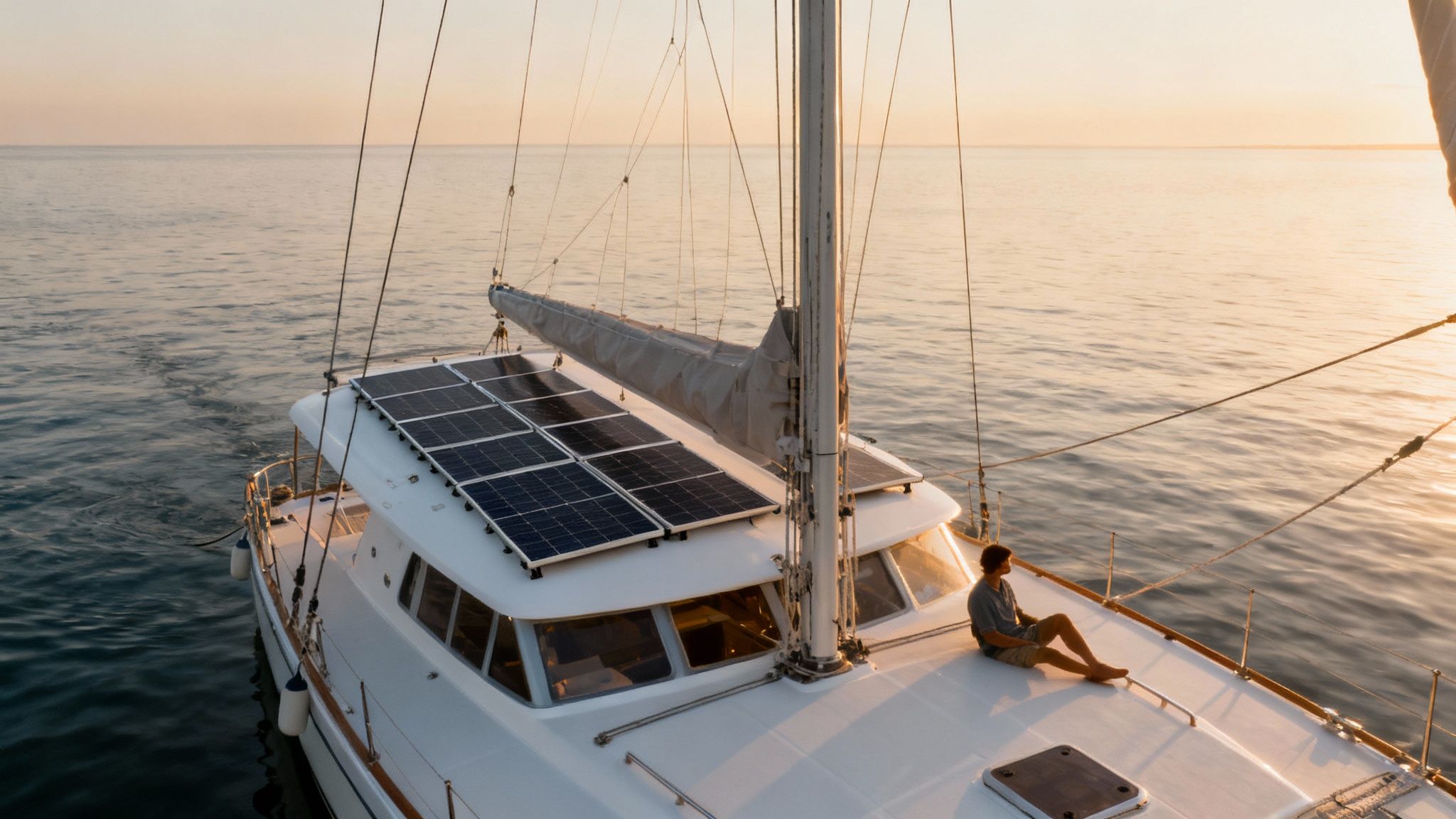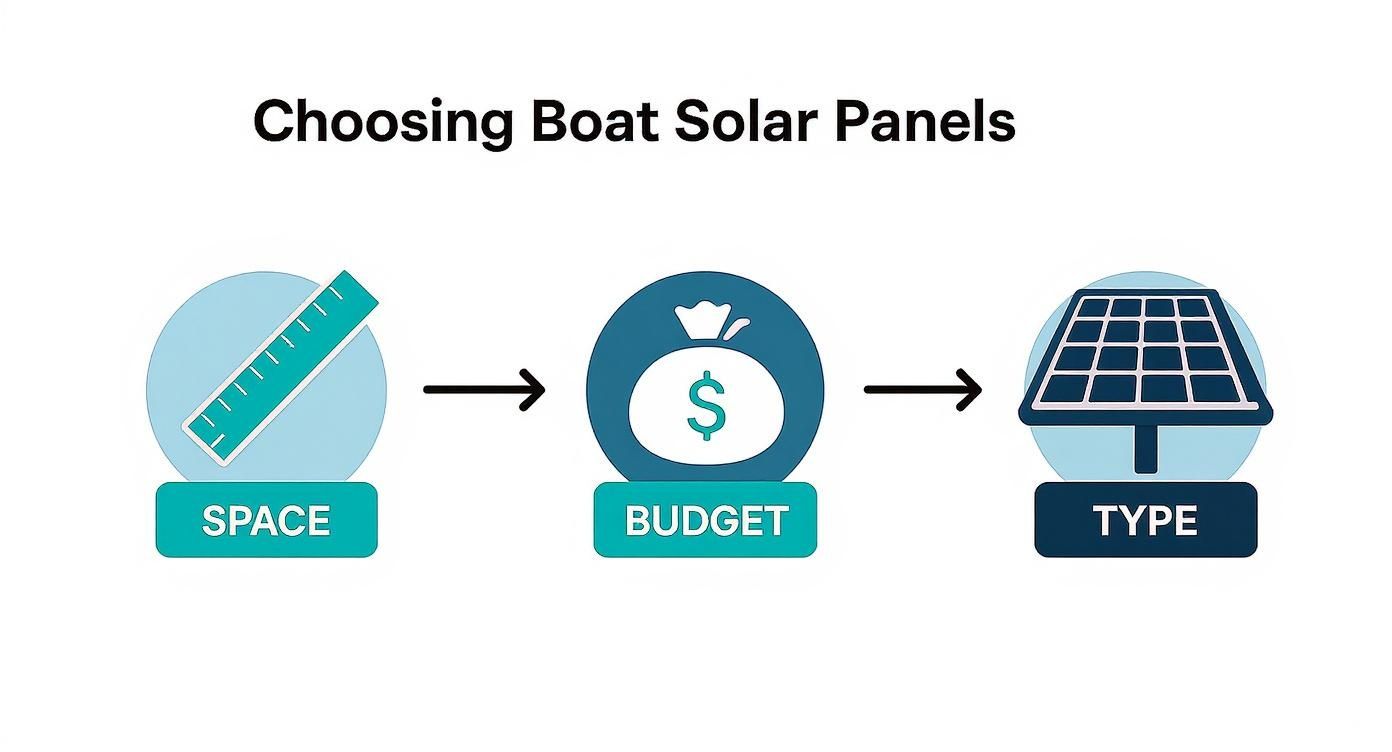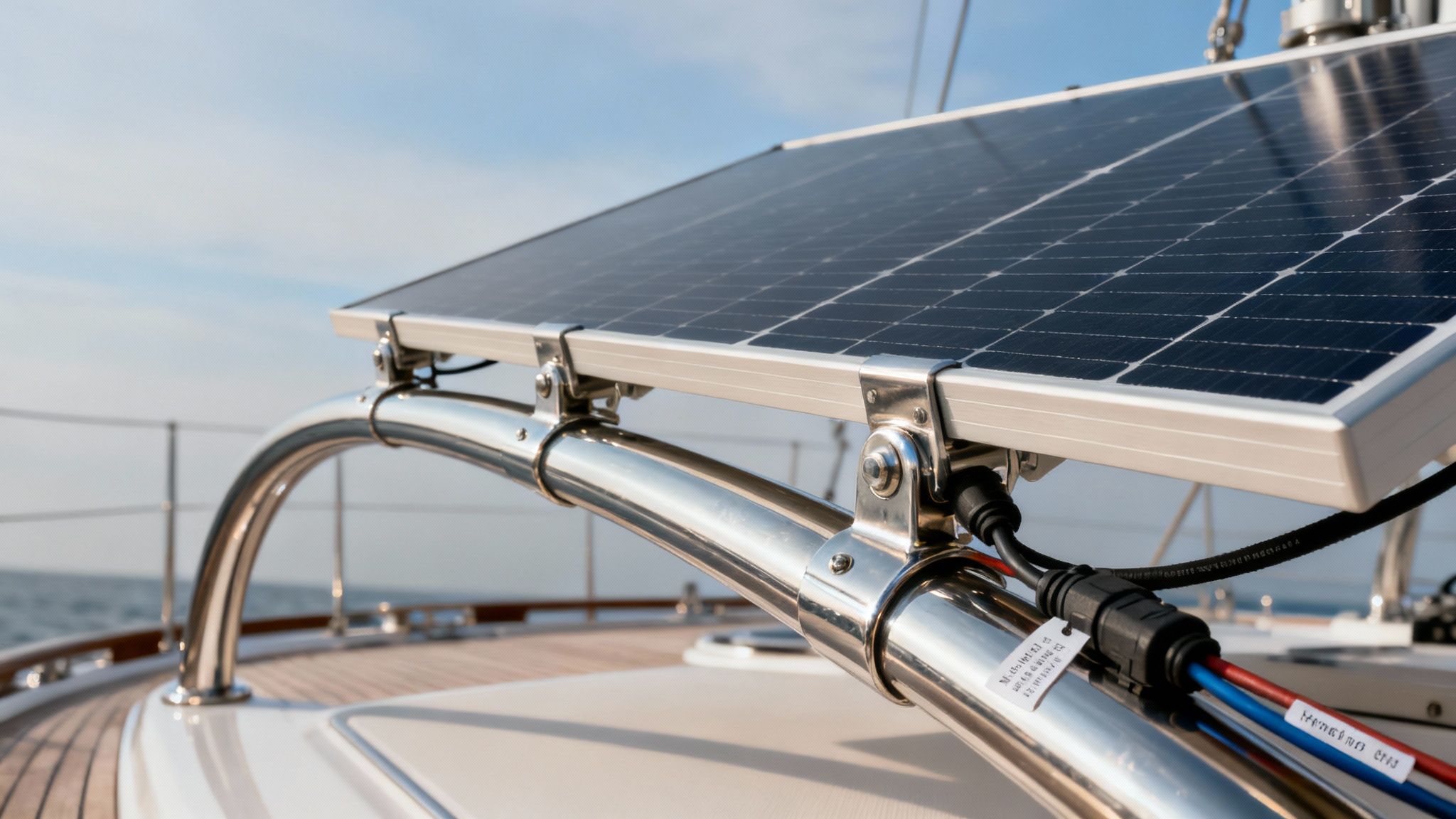
Picture this: a silent, endless fuel tank powering your adventures on the water. That’s the freedom solar panels for boats provide. It’s a powerful upgrade that delivers true energy independence, cuts down on noisy engine runtime, and shrinks your environmental footprint—making it a must-have for any modern boater.

For years, boaters had two main choices: run a loud, fume-belching engine or hunt down expensive shore power at a marina. Solar power completely flips that script. By harnessing the sun’s energy, you create your own clean, quiet electricity right where you need it—out on the water.
This isn’t just a minor convenience; it’s a fundamental shift in how you experience boating. Think of it as installing your own personal power station right on deck. Now you can stay anchored in that secluded cove for days longer, run your essential gear without a second thought, and soak in the peace and quiet without the constant drone of a generator.
The advantages of adding a solar system to your vessel are both practical and financial. You gain far more freedom on the water, all while making a smart, long-term investment.
Here are the key benefits:
Installing a solar system is one of the most impactful upgrades a boater can make. It not only increases self-sufficiency and reduces operational costs but also significantly enhances the resale value of the vessel.
Beyond the practical perks, switching to solar power is a powerful step towards more responsible boating. It’s a direct way to minimise your carbon footprint and preserve the marine ecosystems you love to explore.
By generating zero emissions, you help protect the air and water quality of pristine anchorages. This commitment to sustainability is becoming more important every day. You can find more great ideas in our guide on sustainability tips for boating practices.
This guide is your complete playbook for embracing solar, turning your boat into a more efficient, capable, and environmentally friendly vessel for all your adventures.
To really get the most out of solar panels for boats, it helps to know how the whole system works together. It’s not just a single panel you bolt on; it’s a team of components all working in sync to catch, manage, and store the sun’s energy, giving you reliable power when you’re off the grid.
At its core, the process is surprisingly simple. The photovoltaic (PV) cells in your solar panels soak up sunlight. This energy gets the electrons inside the cells moving, which creates a flow of Direct Current (DC) electricity—the exact same kind of power your boat’s batteries use.
This even happens on cloudy days. A great way to think about it is to picture your panels as a bucket collecting raindrops. Even during a light drizzle, the bucket slowly fills up. On a bright, sunny day, it fills much, much faster. The point is, energy is almost always being collected.
A complete marine solar system has four key players, and each one has a very specific job. Once you understand how they interact, you’ll see how your boat becomes its own floating power station.
Let’s break down the essential gear that makes up a marine solar system and what each part actually does.
Core Components of a Marine Solar System
| Component | Function | Analogy |
|---|---|---|
| Solar Panels | The most visible part of the system. Their only job is to turn sunlight into DC electrical energy. | The Collector |
| Charge Controller | This smart device acts as a gatekeeper between the panels and your batteries, regulating voltage to prevent overcharging. | The Brain |
| Battery Bank | This is where you store the power from your panels, so you can use it day or night to run your gear. | The Reservoir |
| Inverter | If you need to run 240V household appliances (like a laptop or TV), this device converts your boat’s 12V DC power into usable AC power. | The Translator |
Each part is crucial for a reliable and efficient setup, ensuring you have power when you need it most.
The flow of energy is logical and seamless. Sunlight hits the panels, which create DC power. That power then travels through the wiring to the charge controller—the brain of the operation. The controller constantly checks your battery’s charge level and feeds it the perfect amount of power to top it up safely without causing damage.
All that stored energy sits waiting in your battery bank. When you flick on a light or run a pump, you’re drawing power directly from this reservoir. The health of your battery bank is everything, so making sure it’s properly housed and protected is a non-negotiable part of any good installation. Check out our guide on marine battery boxes to learn how to best protect this vital component.
The boat solar panel market is booming, especially here in Australia, as more people chase energy independence on the water. Projections show the Aussie market hitting around USD 500 million in 2025, with a compound annual growth rate of about 12% through 2033. This surge is all thanks to recreational boaters wanting off-grid solutions for longer trips, made even more accessible by the falling costs of panels and batteries. You can learn more about these market growth trends and what they mean for boaters.
This coordinated dance between components ensures you have a steady, reliable power source, turning your boat into a truly self-sufficient haven.
Picking the right solar panels for your boat is about more than just chasing the highest wattage. The marine environment is famously tough—you’ve got constant exposure to salt, moisture, and movement to contend with. Your choice needs to be both powerful and seriously durable. The perfect match will ultimately depend on your boat’s layout, how much space you have, and your budget.
The decision really boils down to three main types of panels: monocrystalline, polycrystalline, and flexible. Each one has its own set of strengths and weaknesses when you put it on the water, and understanding these differences is the key to building a reliable system that will keep you powered up for years to come.
Think of rigid monocrystalline and polycrystalline panels as the workhorses of the marine solar world. They’re generally more efficient and have a much longer lifespan, making them the go-to choice for mounting on hard, flat surfaces like a hardtop, arch, or a clear patch of deck.
Flexible panels, on the other hand, bring incredible versatility to the table. They’re super lightweight and can conform to curved surfaces, opening up installation possibilities on biminis, dodgers, or contoured cabin tops where a rigid panel just wouldn’t work.
Let’s dive into how each one performs in the real world.
Here’s a quick comparison to help you weigh up the options for your boat.
Marine Solar Panel Type Comparison
| Panel Type | Efficiency | Best For | Pros | Cons |
|---|---|---|---|---|
| Monocrystalline | 18-23% (Highest) | Boats with flat, unobstructed space like hardtops or arches. Maximum power in a smaller footprint. | Most efficient, excellent low-light performance, long lifespan (25+ years). | Highest initial cost, rigid and heavy, can be brittle. |
| Polycrystalline | 15-18% (Good) | Budget-conscious boaters with ample space for a slightly larger panel to get the same wattage. | Lower cost than mono, very durable and reliable technology. | Less efficient (requires more surface area), less effective in high heat. |
| Flexible (Thin-Film) | 10-17% (Varies) | Curved or uneven surfaces like biminis, dodgers, and decks where weight is a concern. | Extremely lightweight, versatile mounting, can be walked on (some models). | Lower efficiency, shorter lifespan (3-8 years), higher cost per watt. |
As you can see, there’s a clear trade-off between efficiency, cost, and flexibility. The best panel for you depends entirely on your vessel and how you plan to use it.
For boaters who need to squeeze every last watt out of a limited amount of space, monocrystalline panels are the undisputed champions. Their high efficiency, often hitting over 22%, means you get more power from a smaller footprint. On a crowded boat deck, that’s a massive advantage.
They also perform better in low-light conditions—think overcast days or early mornings—meaning they start producing usable power earlier and keep going later in the day. While they do have a higher price tag, their incredible power output and longevity make them a fantastic long-term investment for serious cruisers.
If you’ve got a bit more deck space to play with and are looking for a more wallet-friendly solution, polycrystalline panels are an excellent choice. They’re made using a simpler manufacturing process, which brings their cost down compared to their monocrystalline cousins.
While they are slightly less efficient, modern polycrystalline panels still deliver great performance and are known for their rugged durability. For many weekend cruisers or boaters with moderate power needs, they hit that perfect sweet spot between cost and performance.
But what if you don’t have a big, flat hardtop to mount panels on? This is where flexible solar panels really shine. Their ability to bend and follow the curves of a bimini or deck makes them incredibly adaptable. They are also feather-light, a critical factor for sailboats and smaller powerboats where every kilogram matters.
The trade-off for all this versatility is a shorter lifespan and lower efficiency. But for many boaters, the ability to add solar to previously unusable areas makes flexible panels a game-changer, unlocking new levels of energy independence on the water.
This newfound energy freedom can even extend to your boat’s propulsion. To see how this works in practice, check out our detailed guide on the latest electric outboard motors in Australia, which pair perfectly with a robust solar setup. By carefully weighing the pros and cons of each panel type against your specific needs, you can design a system that fits your boat and your cruising style perfectly.
Guessing your power needs is a recipe for frustration. A system that’s too small will leave you in the dark, while an oversized one is just a waste of good money. Let’s walk through a practical, step-by-step way to figure out exactly what your boat needs, so you get it right the first time.
Think of it like creating a detailed power budget. Instead of just winging it, we’re going to tally up the real-world consumption of all your onboard electronics. From the fridge and chartplotter to the lights and water pumps, every single device has a power cost. By adding them all up, you’ll know precisely what your daily energy demand is.
Armed with this knowledge, you can confidently size your solar array and battery bank, avoiding the classic mistakes of an underpowered system or overspending on gear you simply don’t need.
First things first, you need to list every single DC-powered device on your boat. Don’t leave anything out, no matter how small. Grab a notepad or open a spreadsheet and walk through your vessel, listing everything that draws from your 12V system.
Once you have your list, you need two key pieces of info for each item:
With those two numbers, you can work out the daily power consumption for each appliance in amp-hours (Ah).
The Simple Formula:
Amps (A) × Hours of Use (h) = Daily Amp-Hours (Ah)
For example, if your cabin lights draw 2 amps and you have them on for about 4 hours a night, their daily consumption is 8 Ah (2 A x 4 h). Simple as that.
Now, just repeat that little calculation for every item on your list. Some devices, like a refrigerator, cycle on and off, so you’ll need to estimate their total runtime. A good rule of thumb for a marine fridge is that it runs about one-third of the time, which works out to 8 hours in a 24-hour period.
Here’s a simplified example of what your energy audit might look like:
| Device | Current Draw (Amps) | Estimated Daily Use (Hours) | Daily Consumption (Ah) |
|---|---|---|---|
| Refrigerator | 4.5 A | 8 h | 36 Ah |
| Chartplotter | 1.5 A | 6 h | 9 Ah |
| Cabin Lights | 2.0 A | 4 h | 8 Ah |
| Water Pump | 5.0 A | 0.5 h | 2.5 Ah |
| Total Daily Demand | 55.5 Ah |
In this scenario, you need to generate and store at least 55.5 Ah every single day just to break even. This number is the rock-solid foundation for sizing both your solar panels and your battery bank correctly.
It’s no surprise that the global marine solar panels market was valued at around USD 150 million in 2023; boaters everywhere are realising the benefits of this reliable power. For Aussie boaters, these systems provide consistent energy for critical gear, and their straightforward installation has definitely boosted their popularity. You can discover more insights about these market trends to see why so many are making the switch.
This simple flow chart visualises the key decisions you’ll make when picking the right solar panels for your boat.

As the infographic shows, it all boils down to your available space, your budget, and the type of panel you want. These are the three pillars of a smart solar investment.
Knowing your power needs is also crucial if you’re thinking about other electric upgrades, like quiet and efficient propulsion. Our guide to the powerful Haswing 3.0hp electric outboards can show you what’s possible with a well-planned electrical system. With an accurate energy audit in hand, you’re ready to build a solar system that truly works for you.

A great solar setup is about more than just buying good panels; it’s about a rock-solid installation that can handle the relentless marine environment. Getting the mounting and wiring right is the foundation of a safe, durable system that performs day in, day out. Nail this part, and your investment will deliver reliable power, voyage after voyage.
From pitching seas to corrosive salt spray, your installation has to be tough. This means choosing robust mounting spots that get maximum sun, but also thinking about practical details like airflow and protecting your wiring.
Where you put your solar panels for boats makes all the difference. The goal is simple: find a spot with the least amount of shade and the best possible airflow. Even a small shadow creeping across a panel from a mast or boom can slash its output dramatically.
Good mounting also helps keep your panels cool. Heat is the enemy of efficiency, and a panel’s performance drops as it gets hotter. Leaving an air gap underneath rigid panels is a simple trick that lets heat escape, keeping them running closer to their peak potential.
Popular spots that just work include:
Your system’s wiring is its lifeblood, and on a boat, it has to be impeccable. Corrosion is the number one threat, so every connection and every centimetre of wire needs to be chosen and installed with the ocean in mind.
This is not the place to cut corners. A single bad connection can bring your whole system down, often at the worst possible time.
Remember, the marine environment is incredibly unforgiving. A connection that works perfectly fine in a house can fail in months on a boat due to moisture and salt. Every detail, from the wire you choose to the type of crimp you use, is critical for long-term reliability.
To make sure your wiring is up to the task, follow these essential rules.
Proper installation is a skill, and for anyone wanting to dive deeper, our collection of articles on expert marine installation techniques offers more detailed guidance. Following these best practices will give you the confidence that your solar system is safe, efficient, and truly built to last.
Think of your solar system as a long-term investment in your boating freedom. Just like any other critical piece of gear on your vessel, a little bit of upkeep will protect that investment and make sure you’ve got reliable power for years to come, especially when you’re miles from shore.
The good news? Solar panels for boats are remarkably low-maintenance. With no moving parts to worry about, your main jobs are simple inspections and a bit of cleaning to keep everything humming along. These straightforward checks will help you get the most out of your system’s performance and lifespan.
Keeping your system in top shape doesn’t demand a lot of your time. By building these quick checks into your regular boating routine, you can spot small issues before they snowball into big problems and ensure every drop of sunlight gets turned into usable power.
Consistency is really the key here for long-term performance.
Think of maintenance as preventative care for your energy independence. A few minutes spent cleaning panels and checking connections each month ensures your system is ready to perform when you need it most, preventing frustrating power shortages out on the water.
The shift towards solar is undeniable, especially as Australia’s small boats market is projected to skyrocket from USD 271.7 million to USD 858.1 million between 2024 and 2035. This massive growth highlights a major move towards greener marine power, where reliable, low-maintenance systems are becoming the new standard. You can read the full research about this market expansion. By following these simple maintenance steps, your solar setup will remain a dependable powerhouse for all your adventures.
When you’re searching for “the best inflatable boats for recreational use available near me” or looking to “compare prices and features of inflatable boats in my area,” you also need a reliable power source. Adding solar panels can power everything from an electric outboard to your navigation gear. Here are the answers to common questions about setting up a marine solar system for your perfect day out on the water.
The honest answer? It comes down to one thing: your daily power usage. There’s no magic number here, which is why doing that power audit we talked about earlier is so crucial. It gives you a target to aim for in daily amp-hours (Ah).
As a rough guide, a 100-watt panel will generate about 30-35 Ah per day in decent sun. So, if your audit shows you’re using around 100 Ah daily, you’ll want at least 300 watts of solar to keep your batteries happy. It’s always a good idea to build in a little extra capacity to cover those cloudy days and other small system losses.
This is a big one, especially for boaters who are tight on deck space. While some premium flexible panels are marketed as “semi-walkable”—meaning you can occasionally step on them in soft-soled shoes—it’s best to avoid it.
Walking on them, especially with hard deck shoes, can create tiny, invisible micro-cracks in the solar cells. You won’t see them, but they’ll quietly kill your panel’s efficiency and shorten its life. If you absolutely have to mount panels in a walking path, look for models specifically built for that abuse. Otherwise, a tough, frame-protected rigid panel is always the more durable choice for high-traffic areas.
Think of a PWM controller as a simple on/off switch for your solar power. An MPPT controller, on the other hand, is like a smart dimmer, constantly adjusting to squeeze every last available watt from your panels and send it to your batteries.
Getting this right is a game-changer for your system’s output. A PWM (Pulse Width Modulation) controller is older, simpler tech. It basically connects your panels straight to your batteries like a switch. It’s cheap, but it’s also pretty inefficient.
An MPPT (Maximum Power Point Tracking) controller is the smart money. It’s a sophisticated device that actively hunts for the sweet spot of voltage and current from your panels, then converts it perfectly for your battery bank. This bit of electronic magic can boost your energy harvest by up to 30%, making it the only real choice for a serious marine solar setup.
If you’re already comfortable with 12V DC electrics and know your way around a toolbox, installing a small solar system can be a really satisfying DIY project. But remember, a boat’s electrical system is a harsh environment where a small mistake can have big consequences.
For those planning to “hire inflatable boats for a family outing in Australia,” having a professionally installed and reliable solar system provides peace of mind that all your essential electronics will work flawlessly. If you’re even slightly unsure about sizing wires or making 100% waterproof connections, bringing in a qualified marine electrician is the smartest move you can make.
Ready to explore the best inflatable boats to pair with your new solar setup? At Easy Inflatables, we design and supply premium, lightweight, and durable inflatable boats, tenders, and kayaks perfect for any Australian adventure. Discover our range and start your journey today. https://easyinflatables.com.au
Experience the ultimate freedom on the water with our top-quality inflatable boats and accessories. Easy Inflatables is your trusted partner, providing everything you need for a safe and unforgettable adventure.
At Easy Inflatables, we believe in empowering adventurers with high-quality inflatable solutions. Our commitment to durability and performance ensures that every product enhances your outdoor experiences.